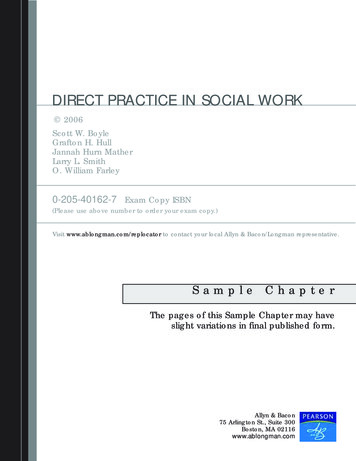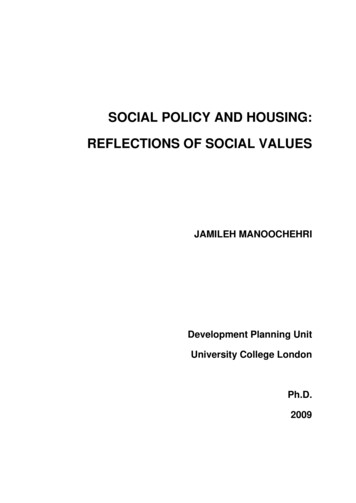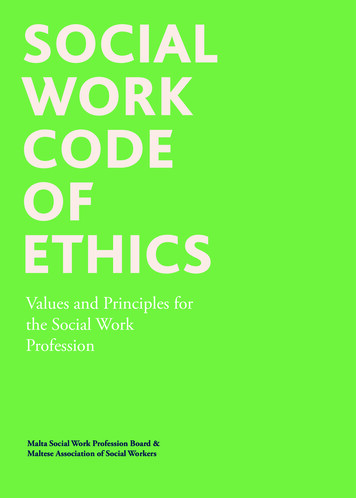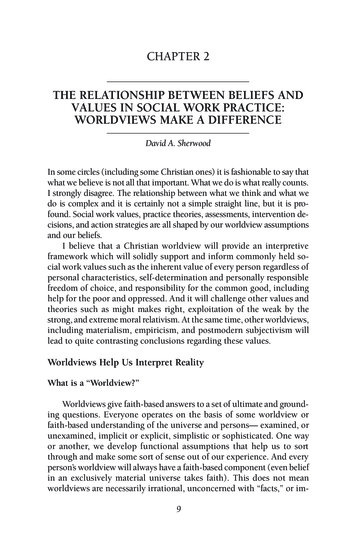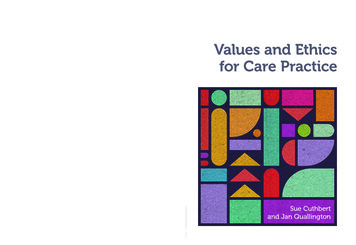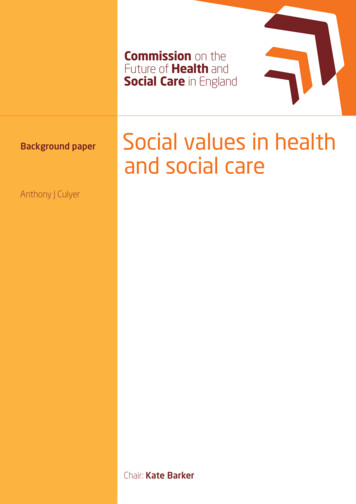
Transcription
Commission on theFuture of Health andSocial Care in EnglandBackground paperSocial values in healthand social careAnthony J CulyerExecutive summaryChair: Kate Barker
The King’s Fund11–13 Cavendish SquareLondon W1G OANTel 020 7307 2400Registered charity: 1126980www.kingsfund.org.uk
Social values in health andsocial careAnthony J CulyerOntario Research Chair in Health Policy and System Design, University ofToronto and Professor of Economics, University of YorkThis paper was commissioned by the independent Commission onthe Future of Health and Social Care in England.The views in this paper do not necessarily represent the views ofthe commission or of The King’s Fund.
Contents3 The King’s Fund 20141 Introduction42 Liberalism versus libertarianism73 The market versus the state84 Public versus private insurance115 Equity versus equality146 Inequalities of health versus inequalities of health care157 Equity versus efficiency168 Needs versus wants179 Prices versus rationing1810 Financial protection versus quality of life1911 Public versus private2212 Agents versus principals2413 Universality versus selectivity2514 Comprehensiveness versus limited benefit bundles2615 Centralisation versus decentralisation2716 Competition versus collaboration2817 Experts versus citizens2918 Mixing values and other things3019 Key messages31References34About the author36
1IntroductionAlmost all decisions about the design of health and social care systems,as well as those to do with their continuing operation, are deeply imbuedwith social values; that is, value judgements about what is good for society.They are not necessarily value judgements by or of society. But, regardlessof source, they are always judgements of value about society. Social valuejudgements are not, however, the only kind of value judgement involvedin system design and operation. There are others, especially in health andsocial care, which relate, for example, to the quality of the evidence used tosupport particular ways of doing things: was the science good science? Canthe data be trusted? Is the thing we use to measure health and its value, orchanges in that value, a truly valid measure of it? Other judgements mayrelate only indirectly to social values and focus instead on predicting factualconsequences, addressing questions like ‘what is likely to happen if ?’ Theymight relate to the behavioural responses people have to system design orchanges in it: is the co-payment for drugs low enough for the needy not tobe deterred from taking their prescriptions? Can fee-for-service paymentsto physicians generate the desired levels of voluntary immunisations? Dolocal commissioning arrangements truly embody the health and sociallyrelevant characteristics of the local populations they serve? Yet otherjudgements are required if one is, say, concerned about the quality of adoctor’s professional performance, or the balance to be struck between usingmanufacturers’ confidential evidence about clinical evidence and maintainingpublic confidence through transparency of National Institute of Health andCare Excellence’s procedures. The social value judgements, however, are theset of values that really underpin all others. Unless the system and the wayit works somehow succeeds in embodying these most fundamental values,then it fails in a very fundamental sense even if it succeeds in its science,data, measures of performance and political success. This paper focuses onsocial value judgements.There are many aspects to social values.They are social. That is, they relate to groups of people and the relationshipsbetween them.They can relate both to processes (how things are done) and to outcomes(the consequences that flow from what is done). This is a distinction betweenends and means. In health and social care, social value judgements arenearly always entwined in the ends sought, such as population health gainand the elimination of avoidable inequalities of health. Means, however,are usually to be judged in terms of their effectiveness in enabling ends tobe realised. Taking one’s medicine is a means to an end (better health).In general, means are justified only by ends. After all, if an end cannotjustify a means, what can? That is not to say that an end can justify anymeans: plainly some means are so awful (say, the torture of children) thatno end could possibly justify them, and some ends (say, the exterminationof unpopular people) so awful that no means could possibly be justified inachieving them. Sometimes ends and means can become confused. Forexample, health care is a means to the end of better health. But better healthis also a means to a more ultimate end: the flourishing life. Sometimes it isnot clear that the means is only a means. Health care and social care may4 The King’s Fund 2014
indeed be means to the end of better and fairer health and fuller lives butone needs to ask if their effectiveness in achieving those ends (and probablyothers too) is all that matters. If it is, then the critical test health and socialcare interventions need to pass is that of effectiveness or, as will be seen, costeffectiveness. One needs to discover and evaluate the evidence for one healthor social care intervention being more instrumental than another in promotingthe ends we seek. But if health and social care are regarded as inherently goodthings as well as being instrumental for more ultimate good things, then suchtests are not enough: we need also to evaluate the interventions not merelyas means but as experiences in their own right. Similarly, is the integrationof health and social care a means to the ends of ‘better health more fairlydistributed’, or something that is inherently desirable? These are matters onwhich a view needs to be taken since the kind of evaluation needed will differaccordingly.Being treated with kindness and dignity is a social value judgement aboutthe processes of health and social care. Treating employees with fair terms ofservice and adequate wages and salaries is a social value judgement aboutprocess. These may or may not be as important as the consequences for healthand quality of life that they generate but they are surely there to be taken intoaccount for their potential to improve or diminish the quality of people’s lives.Valuing a health gain for a very deprived person more than the same gain to aperson not at all deprived is a social value about the outcome of a process ofcare. So is valuing an extension of life over an increase in the quality of life withno extension.Social values have ethical status. What I mean by this is that a social valueis something suggesting that we ought to act in a way reflecting that value.Values are moral principles and ought to be followed, if they can be. There arelots of such values and they may well conflict. For example, the common valuethat available resources in health and social care should be used to have thegreatest possible impact on population health may conflict with the value thatthe geographical distribution of those resources should be equal. Some arguethat an important social value is to seek as far as possible an equal distribution,not of resources, but of health in the population. However, that might involve anunequal distribution of resources in order to make sure that those least healthy,who nonetheless have capacities to benefit from health and social care, getan appropriately greater share. We therefore need to ask what equalities andinequalities matter.Not all values can be fully respected or followed, simply because they arevery demanding. That is not necessarily a bad thing. It is arguably at leastas important to be able to measure one’s shortfalls from perfection as it is tostruggle to attain it. To achieve the perfection of a Christ or the Prophet or theBuddha may be beyond ordinary mortals but that need not devalue the meritof having the standard to aim at. In health and social care it is important toknow what one ideally aims for, but it is also important not to let the perfectbecome the enemy of the merely good when it comes to performance. Not allsurgeons are equally skilled. Not all social workers are equally up-to-date withthe evidence on most effective child protection. Variation is inevitable and canco-exist with the highest standards so long as reasonable ranges of acceptableperformance are laid down.Social value judgements are often controversial. Some view health care as aset of services that is there to be bought as one wishes, as a part of the rewards5 The King’s Fund 2014
structure of society. Others regard these services as a right, with entitlementto receive dependent only on citizenship, or residence, or being a taxpayer, orsimply ‘being’. Even the act of choosing between these four possible categoriesof entitlement might be controversial.Judging the effectiveness of health and social care as a means of improvinghealth outcomes is at the core of much modern health and social care policy.In addressing the question ‘should the NHS make treatment X available?’ onemight reasonably demand to know whether X ‘works’ and, if it does, whetherit works better or worse than feasible alternatives and, if better than thealternatives, whether it is ‘worth’ including on the list of available procedures:‘is it cost-effective?’ – an important topic to be discussed further. Answering thisquestion properly evidently needs more than mere social value judgements.We need to know not just whether it ‘works’ but how good the evidence is, whatgroups of people it works for, how well it works for them and for subgroupswithin the wider group, what contribution it might make to reducing avoidablehealth and social inequalities, and what it would cost.Cost is also a value and no mere matter of accountancy. If we introduce a newhealth care procedure, the cost will have to come out of expenditure elsewherein the NHS –unless there is a concurrent increase in the NHS budget. But lessexpenditure elsewhere will normally imply reduction of service elsewhere anda consequential health loss. The true cost of getting more care (and hencehealth) in one area of activity is therefore the minimum necessary loss of care(and loss of health) elsewhere. This is the important notion of opportunity cost.My purpose in this paper is not to provide answers, though readers may be ableto detect some that are implicit in the way the questions are posed. I do notintend to reveal my own social value judgements. Instead I shall try to outlinesome of the main value judgemental issues that arise in health and social careand indicate what some people have had to say about them. The idea is thatthis may aid discussion and greater explicitness. I must admit to one expressedvalue of my own – that explicitness is nearly always preferable to implicitness. Ithink it leads to better decisions, but I also think it’s the right thing to do (it is ameans and an end).The main way of approaching the issues will be to present them as conflicts.This sharpens them through contrasts and more or less forces the reader totake sides. I have chosen the topics that seem to me to have been characteristicof the post-war history of discussions about health and social care policy in theUK. This gives the following something of the appearance of a lexicon, with thetopics roughly ordered from top level down. In a short space the treatmentcannot be encyclopaedic but I hope readers will at least find it helpful. Thedifficult task of applying the various concepts and ideas is left largely to thereader, space being given only occasionally and briefly to illustrations.6 The King’s Fund 2014
2Liberalism versus libertarianismIn both health and social care, a ‘top-level’ debate about values has concernedthe role of markets and the limits of individualism or collectivism. Thesearguments usually have their roots in the classic clash between liberalism(including liberal socialism) and libertarianism.In contrast to the informal, mostly north American, usage of ‘liberal’ as anymore or less left-leaning political view, liberalism is the doctrine that seeksto combine two values that themselves often clash: respect for individualliberty (liberty of thought, speech, religion, and political action; freedomfrom government interference with privacy, personal life, and the exercise ofindividual inclination) and maintaining a democratic society controlled by itscitizens and serving their needs, in which inequalities of political and economicpower and social position are not excessive but moderated through progressivetaxation, public provision of a social minimum, and the insulation of politicalaffairs from the excessive influence of private wealth and social status.Libertarianism is a doctrine that exalts the claim of individual freedom ofaction, and asks why any state power at all should be permitted – even theinterference represented by progressive taxation and public provision of healthcare, education, and a minimum standard of living.While this paper will not contain any discussion of these two philosophies at thegeneral level, it will at various points touch upon issues whose resolution mayinvolve violation of one or more of the tenets of either; see Nagel (1975) on thetwo ideologies.7 The King’s Fund 2014
3The market versus the stateA western liberal state typically relies on markets to produce and distributegoods and services. For the market mechanism to work well a number of quitedemanding conditions need to be satisfied. The same goes for systems usingmore centralised systems of planning and management and with less relianceon exchangeable private property rights. So no system is perfect. The list ofreasons why the market may fail is, however, a good point of departure forconsidering how far health, welfare and the caring services that support themrequire special forms of organisation, ownership and finance (Culyer 2012e).Part of the case for the NHS is that health is ‘special’. It may be helpful to thinkof two approaches within the ‘health is special’ view (in contrast to the viewthat in all essentials it is no different from any other good or service). These arethe ‘caring externality’ approach and the ‘primary good’ approach. The caringexternality approach starts from the proposition that large numbers of peoplein the community care about the health of fellow citizens (or, simply and moregenerally, fellow humans). They prefer it when not only they themselves arewell and free from sickness and disability and have a good expectation of lifebut also when their friends, neighbours, compatriots are well, etc. The firstthing to note about this view is that it is based on preferences, so one needs toask whether mere preferences are a strong enough base on which to erect acase for the NHS. Second, having a preference for something either for oneselfor for someone else generally implies having a willingness to pay for it, sothe caring externality approach implies that one is willing to pay not only forone’s own better health but also for the better health of others. One may beunlikely to place as high a value upon it as upon one’s own health, or that ofone’s nearest and dearest, but some positive value is implied. From this, it isa relatively short step to concluding that health services are probably sensiblyprovided at subsidised prices, to encourage their use, and that access to themshould be made as easy as practicable so that diagnoses can be made and aneed for treatment assessed. It may also be thought to follow that health careought to be provided, at least in part, either by charitable organisations (as itwas in the west for centuries by the churches) or by the state.The primary good approach does not depend on preferences. Instead it is basedon a view that health is so fundamental a human attribute for the attainmentof a flourishing life, and its absence so potentially destructive of the flourishinglife, that it has a special moral status among other primary goods, like accessto the law in defence of one’s rights, and rights to minimal levels of education.Having a flourishing life becomes the ultimate yardstick for human welfare. Thefact that more health may also be preferred to less is, on this view, of lessersignificance. Instead, health is usually needed if one is to live a fulfilling life. So,if health and social care are needed for health, and health (among other things)is needed for the flourishing life, then health and social care are also neededfor people to have flourishing lives. Of course, it is easy to point to individualswith devastatingly poor health who somehow triumph over adversity andachieve remarkable things and appear to be extremely happy people. But theseare probably rather special people. Others may be crushed by ill health. Andtriumphing over adversity is surely a rare accomplishment worthy of unusualadmiration. It is in this sense that health is a primary characteristic and healthand social care are primary goods; two related (but not at all the only) means ofdelivering that health.8 The King’s Fund 2014
Something that differentiates these two views – the caring externality and theprimary good approaches – is that the second tends to be more egalitarian.You might find it as hard to justify large but avoidable differences in people’spossession of a primary good like health as it would be to justify large butavoidable differences in their flourishing as individuals. If so you should seekways of allocating health and social care resources so that they not only haveeffective impact on health and welfare but also tend to reduce avoidableinequalities in health.Another implication of both is that a particular focus of policy attention becomespopulation health. An over-simplified characterisation might be that the correctpolicy on these views becomes one of (a) maximising population health (outof the resources allocated to health and social care) and (b) ensuring thatavoidable inequalities in health are minimised.A very important implication, again of both views, is that the health and socialcare services have this character of being ‘special’ only if they are effective.That is, only if they work as a means to the end of better and fairer health.Ineffective health and social care does not benefit people’s health, so how canits public subsidy be justified? Likewise ineffective health and social care willcontribute nothing to fairer distributions of health in the community (Culyer2012b).The question immediately arises: is it possible to separate health and socialcare interventions that work from those that don’t? The answer is not only‘yes’, but we also have an institution in the NHS (National Institute for Healthand Care Excellence – NICE) whose principal task is to assemble the relevantevidence and make recommendations to the NHS about treatments that workand the patients for whom they work best.Discovering what works and what does not, what does harm, and what worksbut not sufficiently well to be preferred over other treatments that work better,requires research and the gathering of reliable information. It also requires thatthe professionals who prescribe health or social care treatments can interpretthe evidence and that the manufacturers of medicines and clinical equipmenttest them for both safety and effectiveness and share the resultant information(even when it is commercially unfavourable to them). The history of healthcare, both before the NHS was founded and since, is littered with examplesof harmful, ineffective or insufficiently effective interventions. A well-knownexample of a treatment that did more harm than good was the sleeping pillthalidomide. Introduced in the NHS towards the end of the 1950s, thousandsof deformed babies worldwide were the innocent victims of an insufficientlyresearched drug. Diethylstilboestrol (DES) was once a popular treatment forthe prevention of miscarriages and stillbirths. If doctors had known how todistinguish the reliable research available in the 1950s from poorer research,far fewer of them would have prescribed DES, which carried unacceptable risksof cancer and damage to women’s reproductive systems. Of course, in caseslike these there was no harmful intent but the consequences were nonethelessharmful.The risk of serious harm is not confined to drug treatments. Some implantsand prostheses are poorly researched and have harmful consequences, evenpreventive measures like screening can harm, in cases where there is a highfrequency of false positives or false negatives: the former cause unnecessaryalarm and further diagnostics and the latter reassure doctors and patientsalike that there is nothing wrong when in fact treatable disease is present.9 The King’s Fund 2014
Even an intervention as ‘low-tech’ as how best to put baby to bed has beenproven dangerous. Dr Benjamin Spock’s book Baby and child care, was thestandard guide to parenting for many years. From 1956 on it contained thefollowing apparently logical advice to thousands of mothers: ’There are twodisadvantages to a baby’s sleeping on his back. If he vomits, he’s more likely tochoke on the vomitus. Also he tends to keep his head turned towards the sameside, this may flatten the side of his head I think it is preferable to accustom ababy to sleeping on his stomach from the start’ (cited in Chalmers 2003, p 23).As Iain Chalmers has commented, reflecting on his own early days as a medicalpractitioner, ‘No doubt like millions of Spock’s other readers, I passed on thisapparently rational, theory-based and authoritative advice. We now know fromthe dramatic effects of the “Back to Sleep” campaigns in several countries thatthe practice promulgated by well-intentioned experts like Spock led to tens ofthousands of avoidable sudden infant deaths’ (Chalmers 2005, p 229). Manyother examples can be found in Evans et al (2007).The message is that NHS expenditure on harmful interventions ought to bestopped or, preferably, prevented through adequate research, knowledge,translation and professional uptake. but so ought public expenditure onineffective and unproven interventions. Disinvestment in harmful, unproven,ineffective and cost-ineffective procedures is at least as important as notinvesting in such procedures in the first place. But they are tasks, one mustadd, that are more easily stated than implemented (Pearson and Littlejohns2007). Even effective interventions ought not to be provided publicly if otherinterventions are at least as effective or more cost-effective in the sense thatfor the same cost better outcomes could be obtained by using alternativeprocedures. Sorting the wheat from the chaff among interventions is whathealth technology assessment (HTA) is about. Helping health professionalsof all kinds to use only the most effective procedures is what professionalguidelines are about. These methods are now well established in the NHS,where NICE has a key role in providing both, but currently sadly lacking insocial services.But, if you do not subscribe to either the caring externality or the primary goodapproaches, and especially if you tend to the libertarian end of the politicalspectrum, then not only will you regard NICE and its purposes as essentiallymischievous but you will reject in their entirety both arguments for stateintervention of the sort that eases access and promotes equality. The marketwill do. Caveat emptor (buyer beware!). This is a ‘top-level’ choice about ‘toplevel’ social values.Hidden in this account is the presumption that it is indeed an aspiration tomaximise the impact of resources on health. There are ample ministerialpronouncements that seem to imply that this is a major purpose of the NHS butit ought not to be taken for granted.10 The King’s Fund 2014
4Public versus private insuranceAn initial concern that the NHS was founded to address was the cost ofaccessing health care: before the Second World War it was for many peopleprohibitive, while those who could afford it could still ensnare themselves withimmense and catastrophic expenditures. With the tremendous developmentsin medicine since then, the potential personal costs of care have risenastronomically. It is not unusual, for example, even in the wealthy US, forfamilies who are without insurance to fail to receive the care they need or forthem to have to sell or remortgage their home in order to be able to pay forthe care they have received (eg, Ayanian et al 2000). Health care expensesare (save for known pre-existing conditions) insurable, however, and theopportunities for doing so are very much greater than they were between thetwo world wars. The question still arises, therefore, as to how best to organiseinsurance against medical costs.Modern insurance markets are sophisticated and offer many choices ofcoverage, premium payments and ‘co-payments’ (further contributions by thepremium payer when services are used). Insurance companies also have tocheck for fraudulent claims (both from their insured clients and from healthcare agencies who may overcharge) and they will incur advertising and othermarketing costs. Public (social) insurance via contributions or taxation also haspros and cons. Whatever the system, however, four apparently technical butactually quite key matters warrant special attention: the contents of the insuredbundle, the socio-economic gradient, moral hazard, and adverse selection.The insured bundleIn a market, the services to which one is entitled and the conditions attaching totheir receipt are a ‘bundle’ offered by insurance companies. In practice, bundlesvary widely and there are major issues of comprehensibility for many clients.They are also often offered as a benefit of employment, with the consequencethat becoming unemployed may lose a family its health insurance cover.Most high-income countries have safety net schemes of varying degrees ofcompleteness, like Medicaid in the US (a programme for low- income residentsaddressed particularly to families with children, pregnant women, children, theaged, the blind and the disabled) and Medicare (a programme mainly for olderpeople) that offer care for a partial bundle with low or zero co-payments.The issue of social value is whether there ought to be a generally agreed bundle(of effective services), that is available to all, and that is explicit and accessedon terms that are consistent with the underlying values of the health caresystem. How that matter is resolved will depend on where one is on the liberal/libertarian spectrum among other things, including affordability and adequateavailability of the appropriate clinical skills in appropriate and accessible places.The socio-economic gradientIn general, the richer one is, or the higher one’s socio-economic class, thelonger one may expect to live. In addition, the richer one is the better one’shealth status is at all stages of that longer life. This is the ‘gradient’. It wasfirst systematically identified in the Whitehall studies but has been replicated11 The King’s Fund 2014
many times over in Britain and abroad (see Marmot et al 1991). It has manyimplications of which two are especially relevant in the context of social values.First, it is not just ‘us and them’ – the rich and the poor. The characteristic ofa gradient is that wherever you are in the socio-economic scale, a movementup will enhance your health and expectation of life and a movement down willdo the reverse. Second, insurance premiums are usually set in such a waythat the higher your risk and the costlier your expected treatment, the higheryour premium. The gradient therefore implies that the poorest people face thehighest premiums and the richest the lowest premiums, and so on throughoutthe gradient. Whether this is of concern will depend upon where you are in theliberal/libertarian spectrum. If it is of concern, then means need to be foundof reducing both the unequal burden of premium payments and the unequalaccess to care.Moral hazardInsurance has the effect of reducing the price of care for those insured. In theextreme, the price is reduced to zero. Two things follow. First the incentiveis reduced to avoid the need for health and social care at least in respect ofthe financial burden it would have created. This is called ex ante (based onforecasts) moral hazard. Second, as the price of anything, including care, falls,more is demanded. In particular, more than is really needed may be demanded,and it is likely also to be supplied by hospitals and other providers, so longas they know they will be reimbursed by the insurer. This is called ex post(based on results) moral hazard. These issues arise both in public and privateinsurance. The main question involving social values relates to the methodsused to control both kinds of moral hazard: for example, no-claims bonuses orhealth education, preventive programmes and public health programmes tocontrol ex ante moral hazard; co-payments or rationing by needs and waitingtimes to control ex post moral hazard.Adverse selectionPerfect risk discrimination by insurers whereby the smallest differentialrisk or cost of treatment between individuals is reflected in the premium, israrely possible. Instead, they tend to set their premiums in relation to theexperience of groups defined by, for example, age, gender, lifestyle, familysize. If members of groups have different probabilities of illness (or at any ratebelieve they have different probabilities) then those with low probabilities (orlow perceived ones) may choose not to buy insurance because the premiumhas been set with high risk users in mind, while those with high probabilities (orperceptions) may eagerly seize their opportunity. If this happens, and insurerscannot identify those likely to demand more or less, insurers end up with clientswho are likely to prove to be much costlier than expected; premiums will haveto rise. High- risk high-cost individuals tend to drive out low- r
Social values in health and social care Executive summary Chair: Kate Barker Background paper Anthony J Culyer Commission on the Future of Health and Social Care in England. The King's Fund 11-13 Cavendish Square London W1G OAN Tel 020 7307 2400 Registered charity: 1126980 www.kingsfund.org.uk.



